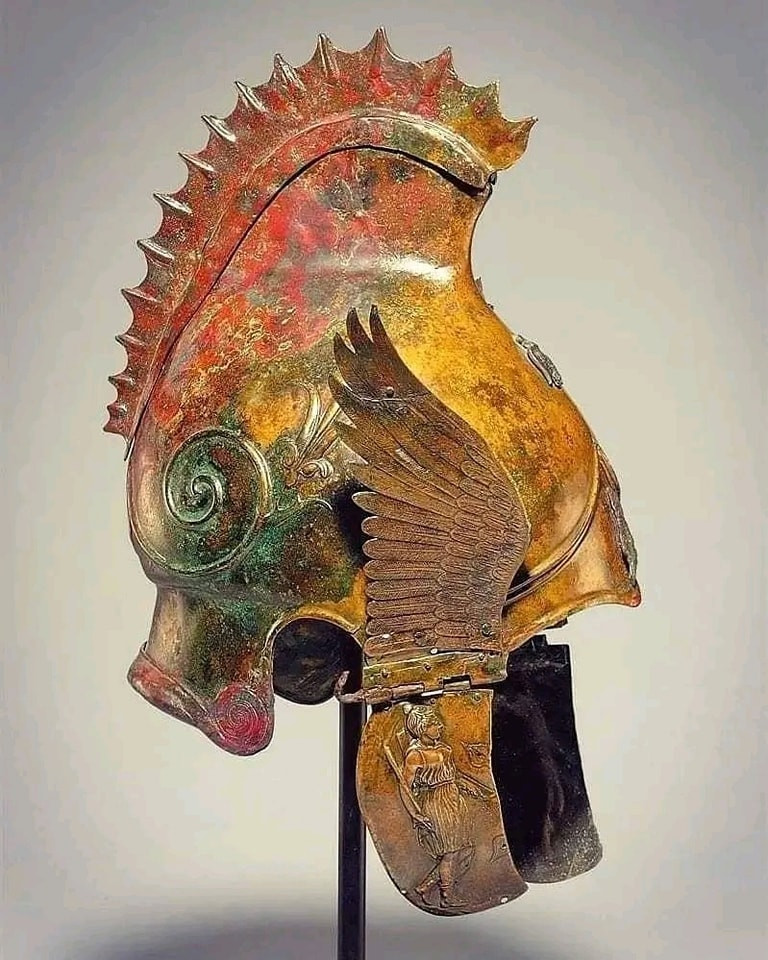In the sun-drenched landscapes of ancient Greece, a discovery emerged from the earth that would forever intrigue and inspire humanity: a bronze winged helmet of the Phrygian-Chalcidian type. Unearthed by archaeologists, this remarkable artifact, dating back to the 4th century BC, encapsulates the brilliance of Greek craftsmanship, the profound symbolism woven into its design, and the enduring cultural legacy of a civilization that continues to shape our modern world.
The Artisan’s Mastery: Forging Perfection
As the dawn broke over the vibrant city of Athens, an accomplished metalworker approached his forge with purpose and precision. The rhythmic clang of his hammer filled the air as he transformed a malleable sheet of bronze into the aerodynamic form of a helmet. This was not just any helmet; it was destined to be an object of admiration, crafted for a warrior of prominence or a leader of renown. Each strike of the hammer carried with it the artisan’s unmatched expertise, honed through years of dedication and skill.

The crowning feature of this helmet was its intricately designed wings. The artisan, with painstaking attention to detail, affixed these embellishments with the utmost care. These were not mere decorative flourishes. The wings symbolized divine connection and swiftness in battle, evoking the imagery of Hermes, the messenger god. To the Greeks, such details were imbued with deep meaning, blending artistic beauty with profound cultural significance.
When the final polishing strokes brought the bronze to a radiant sheen, the artisan stood back to admire his creation. The helmet’s surface shimmered in the flickering light of the forge, a testament to both his artistic vision and technical mastery. This was a creation that would not only protect its wearer but also inspire awe and respect, its wings gleaming like a beacon on the battlefield.
The Helmet’s Epic Journey: From Warrior’s Pride to Archaeological Treasure
For decades, perhaps even centuries, the helmet graced the head of a warrior whose deeds were likely celebrated in their time. It witnessed the chaos of battles, the clamor of shields, and the clash of swords. Its wings seemed to carry its wearer through the fray with the agility and speed of Hermes himself, lending both protection and an aura of invincibility.
Yet, as history marched on, empires rose and fell, and this magnificent artifact was lost to time. Buried beneath layers of soil, it became part of the earth’s silent tapestry, a relic awaiting rediscovery. For centuries, it remained hidden, untouched and unseen, as civilizations flourished and faded above it.
The moment of its rediscovery was one of meticulous care and unbridled curiosity. Archaeologists, with tools in hand and hearts full of wonder, carefully unearthed the helmet. The soil that had encased it for so long gave way to reveal the gleaming bronze, remarkably preserved despite the passage of time. This was not just a helmet; it was a window into a bygone era, a tangible connection to the warriors and artisans of ancient Greece.
A Testament to Ingenuity: Insights from the Past
Today, the bronze winged helmet is more than just an artifact; it is a storyteller. Displayed in museums and examined in research facilities, it captivates both casual viewers and dedicated scholars. Its design offers a glimpse into the military strategies of Classical Greece, where innovation and artistry converged to create tools of both war and cultural expression.
The helmet’s construction reveals much about the metallurgical techniques of the time. The precision required to shape and mold bronze into such a complex form speaks to the advanced skills of Greek artisans. The wings, with their intricate details, demonstrate a level of craftsmanship that continues to inspire admiration. For researchers, the helmet provides clues about the materials, tools, and methods used in ancient Greek metallurgy, adding depth to our understanding of their technological achievements.
Beyond its physical construction, the helmet also serves as a cultural artifact, shedding light on the symbolic and spiritual beliefs of the Greeks. The wings, a recurring motif in Greek art and mythology, reflect the civilization’s reverence for the gods and their attributes. To wear such a helmet was not just to don protection; it was to invoke the favor of divine forces, to channel the power and speed of Hermes, and to embody the ideals of bravery and excellence.
The Legacy Lives On: A Bridge Between Eras
As we marvel at the bronze winged helmet today, its legacy resonates far beyond its original purpose. It stands as a testament to the timeless spirit of human creativity, a reminder of the enduring connection between art and function. What was once a symbol of divine favor and military might now serves as a bridge between the ancient and modern worlds, inspiring new generations to appreciate the ingenuity and artistry of Greece.
In its gleaming surface, we see more than the reflection of a well-polished artifact. We glimpse the echoes of a civilization that valued both the tangible and the transcendent. The helmet represents not just the practical needs of a warrior but also the aspirations of a society that sought meaning and beauty in every creation. It tells a story of resilience and continuity, reminding us that while time may bury the past, it can never erase its impact.
The bronze winged helmet of the Phrygian-Chalcidian type continues to inspire awe, inviting us to explore the depths of history and connect with the people who shaped it. Its story is one of triumph—of an artisan’s skill, a warrior’s courage, and a civilization’s enduring legacy. As we study and preserve this remarkable artifact, we honor not just the ancient Greeks but also the universal human quest for knowledge, creativity, and meaning. Through this helmet, the spirit of Classical Greece lives on, reminding us of the shared heritage that binds us to the past and guides us into the future.





